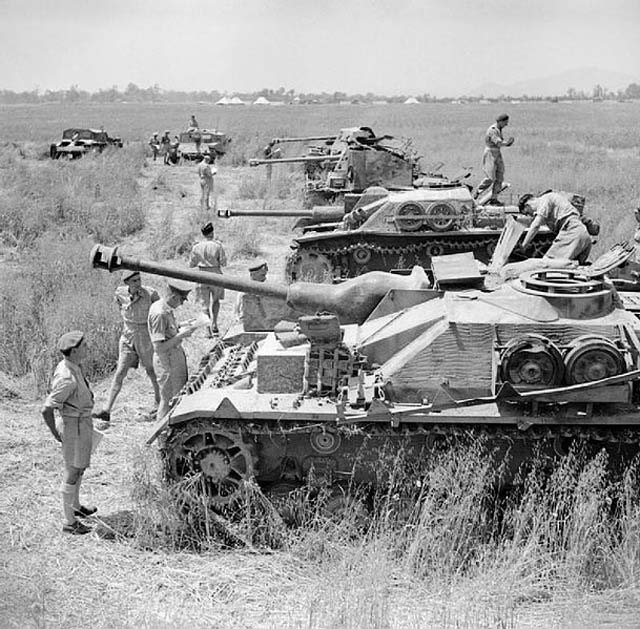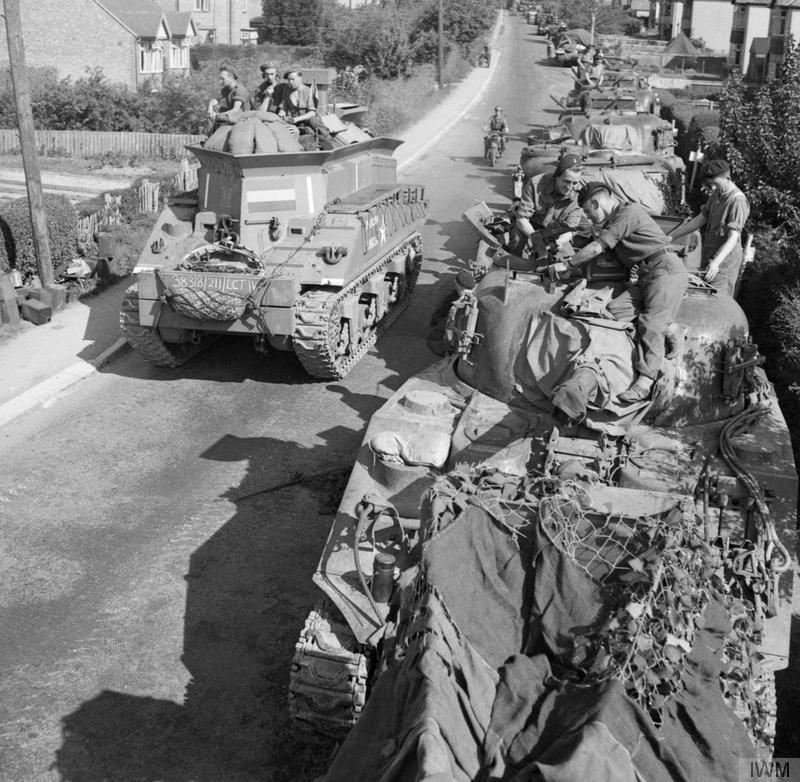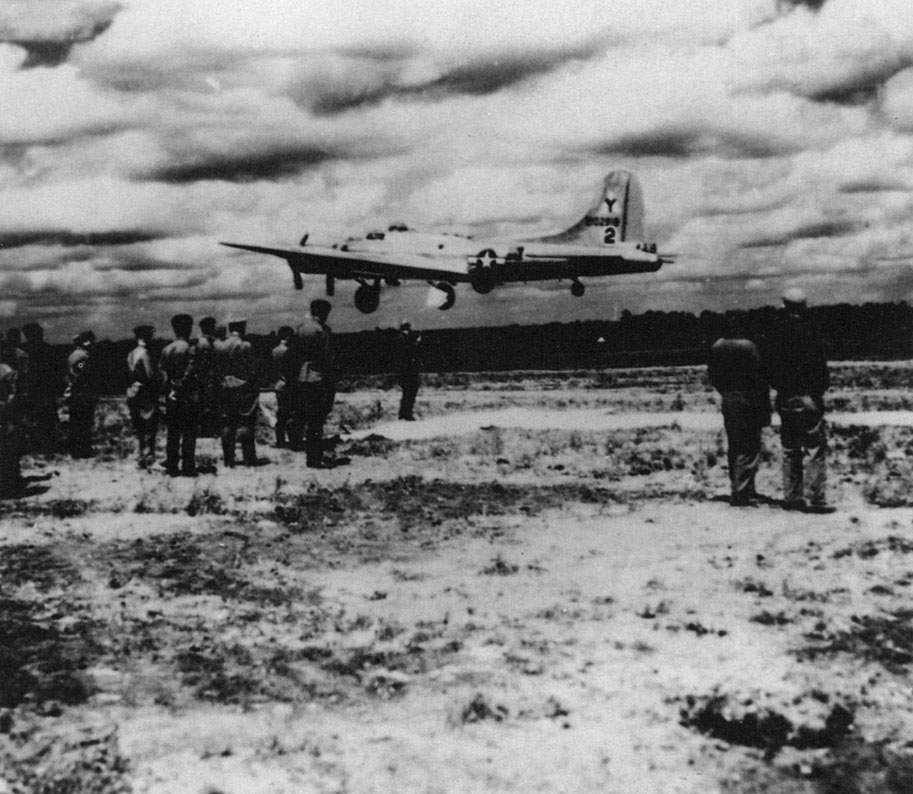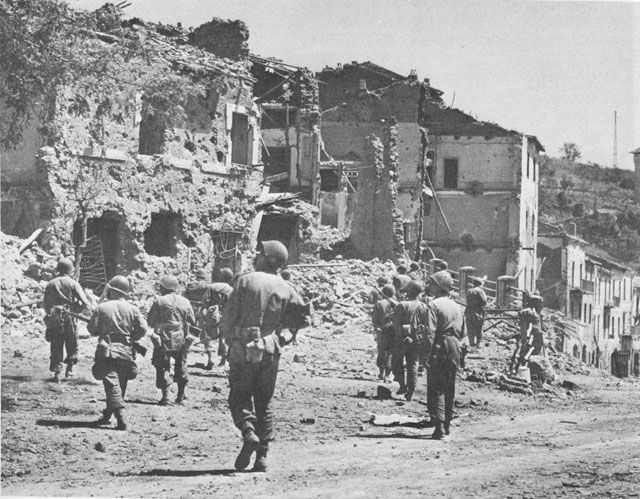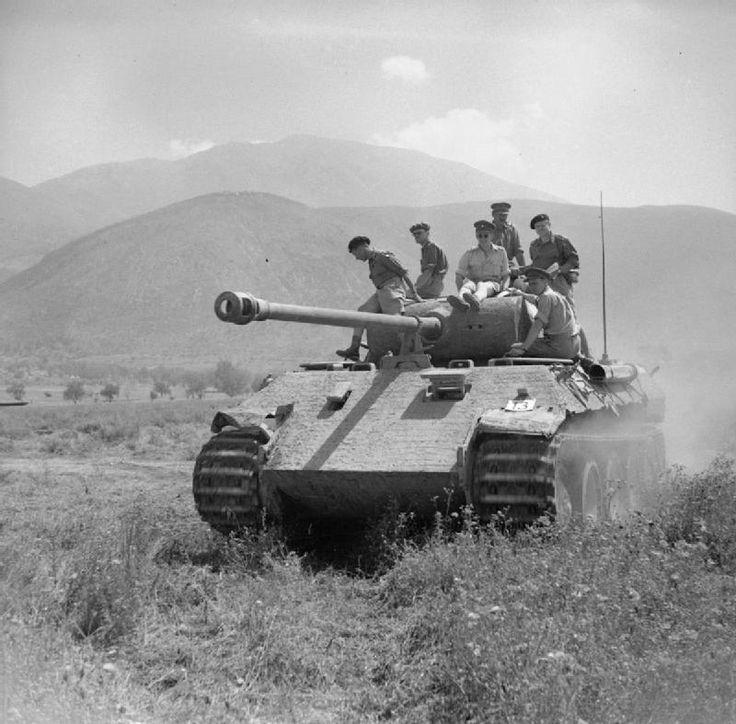Air Operations, Carolines
5th Heavy Bomb Group B-24s are weathered in at Momote airfield on Los Negros, but 15 307th Heavy Bomb Group B-24s are able to attack the Truk Atoll, as planned.
[Air Operations, CBI
BURMA- 12 7th Heavy Bomb Group B-24s are unable to locate their primary target at Yenangyaung, but they do attack secondary targets in the area.
- More than 80 14th Air Force P-51s and P-40s attack numerous sampans on Tungting Lake and Japanese Army ground troops and motor vehicles at Chungyang and Tengchung.
- 3rd CACW Fighter Group P-40s down 7 Japanese fighters over and near Chenghsien in an early-morning engagement.
- 10th Air Force B-25s airlift ammunition to Imphal.
Air Operations, Europe
The first 'shuttle' raid by 130 B-17s of the 15th Air Force takes place as Operation FRANTIC. Italian-based bombers attack the Debrecen railway yard in Hungary, then fly on to the Ukraine escorted by Marauders and Yak fighters. The 8th Air Force attacks V-1 sites in Pas de Calais. RAF Typhoons attack the Dieppe-Caudecote radar statsion.
RAF BOMBER COMMANDEvening Ops:
- 128 aircraft attack the railway yards at Trappes. Included in this total are 105 Halifaxes, 19 Lancasters and 4 Mosquitos of Nos. 1, 4 and 8 Groups. Most of the bombs fall on the eastern half of the target area.
- 15 Halifaxes and 1 Lancaster are lost.
- 103 Lancasters and 4 Mosquitos of Nos. 1 and 8 Groups attack a radar-jamming station at Berneval with great accuracy and without a loss.
- 271 aircraft including 136 Lancasters, 119 Halifaxes, and 16 Mosquitos, attack 4 coastal gun positions. In only 1 area is the bombing accurate, but not a concern because this is part of the invasion deception plan. All of the targets are in the Pas de Calais, not in the Normandy area.
- 23 Mosquitos are sent to Leverkusen, 4 to Laval and 3 to Lison, 53 aircraft lay mines from Dunkirk to Brest, 36 aircraft are on Resistance operations, and there are 9 Serrate and 6 Intruder patrols and 16 RCM and 11 OTU sorties. 1 Stirling is lost on a Resistance operation.
FRANCE:
- During the morning, 805 8th Air Force B-17s and B-24s attack 64 V-weapons sites without loss.
- During the afternoon, 163 8th Air Force B-17s divert from Patis and attack the Beaumont-sur-Oise, Caen/Carpiquet, and Conches Airdromes. 74 B-24s attack the Bretigny, Creil, and Villeneuve Airdromes.
- 2 B-17s and 5 B-24s are lost
FRANCE:
- Throughout the day, nearly 350 IX Bomber Command B-26s and A-20s attack V-weapons sites and coastal defense batteries along the English Channel coast.
- 9th Air Force P-38 and P-47 dive-bomers attack rail bridges and junctions, V-weapons sites, and fuel dumps.
ITALY:
- 12th Air Force B-25s and B-26s attack rail and road bridges between the battle area and Rome.
- XII TAC fighter-bombers attack German Army command posts, rail and road bridges, and motor transport throughout the battle area.
HUNGARY:
- In the 15th Air Force's inaugural mission of Operation FRANTIC, 130 B-17s from four groups of the 5th Heavy Bomb Wing, escorted by 70 325th Fighter Group P-51s, leave their bases in Italy to attacl strategic targets deep in central Europe (in this case, a mashalling yard at Debreczen, Hungary) and then fly on to land at USAAF-run bases (Eastern Command) in the southern Soviet Union -- bombers at the Mirgorod and Poltava Airdromes, and fighters at the Piryatin Airdrome.
- 15th Air Force B-17s attack a marshalling yard at Oradea, and B-24s attack marshalling yards at Cluj and Simeria.
Air Operations, New Guinea
- V Bomber Command B-24s attack the Mokmer airfield on Biak.
- 17th Reconnaissance Squadron B-25s and 3rd Light Bomb Group A-20s attack targets of opportunity on Biak Island.
- B-24s and B-25s attack bivouacs near Sawar and the Wiske River, and roads along the Orai River.
- B-25s attack the Kaukenau and Timoeka areas.
- B-24s, V Fighter Command P-39s, and RAAF aircraft attack the Wewak area.
- At 1640 hours, a large formation of Japanese Navy aircraft based at Sorong attack 8 US Navy LSTs off Biak Island. There are no USAAF fighters in the area due to bad weather over their bases, so the Japanese are able to strafe the LSTs. The attacks continue in piecemeal fashion for 65 minutes, but intense antiaircraft fire from the LSTs and shore batteries down 12 of an estimated 54 attackers, and very little damage is sustained by the LSTs.
Allied Planning
The British and American Chiefs of Staff reach a compromise agreement on the strategy to be followed in Southeast Asia. The airlift between India and China is to be further strengthened so as to play a part in the Pacific operations as well as in China. Land operations are to be undertaken and maintained to the extent that they can help to increase the volume of supplies from India to China; to the end the capture of Myitkyina area in northern Burma and the reopening of the land route from India to Burma, including the construction of an oil pipeline into China, are of the first importance.
[Britain, Home Front
The Cambridgeshire railway station is wrecked by an explosion on a munitions train.
[CBI
BURMAThe final siege of Myitkyina begins. The Chinese dig tunnels to get inside the enemy lines. On the Salween River front, the Chinese 36th Division captures the village of Kaitou and surrounds Chiaotou, in the valley of the Shweli. On the Arakan front the Indian Divisions have re-established contact and resumed the initiative against the Japanese, advancing towards Akyab.
CHINAJapanese units win all their objectives in Honan Province and halt offensive action.
INDIAOn the Indian front, where there is bloody fighting around Imphal, the British-Indian forces can now call on 100,000 effectives. The Indian 7th Division brought back from the Arakan, succeeds in breaking through the lines of the Japanese 31st Division north of Kohima. The Japanese begin to withdraw slowly.
[France, Politics
The French Committee of National Liberation restyles itself the Provisional Government of the French Republic.
[Italy
As Kesselring's forces gradually pull back the Allies are able to advance all along the front. The US forces reach Route 6 at Valmontone, which they take, and also in other sectors. They also make good progress in the Alban Hills.
In the US II Corps sector, units of the 85th Div capture Maschio d'Ariano, Monte Fiore and Monte Ceraso, pushing on as far as Highway 6, though this is 'cut' beyond San Cesareo by troops of the 88th Div. The 7th and 30th Regts of the US 3rd Div continue to advance in the Palestrina and Valmontone areas - the latter recently abandoned by the Germans.
Alexander calls on the people of Rome to save the Eternal City from destruction.[MORE]
[New Guinea
The fighting on Biak continues. The 186th Infantry attacks to the west along the inland plateau toward the airfields against sporadic but persistent opposition. They reach positions almost abreast of those of the 162nd Infantry in the Ibdi area. The 2nd Battalion, 162nd Infantry, joins the 186th Infantry it its effort and is attached to it. In the coastal sector, the 162nd Infantry recovers the water hole, reduces the roadblock, and blocks the trail leading inland forcing the Japanese out of one of their positions.
Company A, 163rd Infantry, occupies Owi and Mios Woendi Islands.
In the Hollandia-Aitape area, TF PERSECUTION's 1st Battalion, 126th Infantry, is formed into 2 forces: Herrick Force is to hold Yakamul; Bailey Force is to patrol southward from Yakamul along the Harech.
[Operation OVERLORD
After receiving the first part of what is believed to be a coded message to alert the Resistance of imminent invasion, the German 15th Army is alerted. By an ommission due to a misunderstanding between the Army Supreme Command, Jodl, Western General Headquarters, von Rundstedt, and the headquarters of Army Group B, Rommel, the 7th Army, which guards the Normandy coast, never gets the warning.
In England, from a caravan in a wood near Portsmouth, Gen Eisenhower issues orders for the invasion. The has under him 3 million men - 1,700,000 Americans, 1,000,000 British and Canadians and 300,000 Free French, Poles, Belgians, Dutch, Norwegians and Czechs.
For the next three days, the 8th Air Force will attack transportation and aifields in France and attack coastal defenses in the Pas-de-Calais area, to provide a diversion that will focus German attention on the expected invasion area, rather that the actual invasion area in Normandy.
[Pacific
- The Japanese frigate Awaji is sunk by the US submarine Guitarro (SS-363) off Formosa.
- The US submarine Shark (SS-314) attacks a Japanese convoy about 600 miles northwest of Saipan and sinks the transport No.2 Chiyo Maru (4700t).
Images from June 2, 1944
|
|
|
|
|
|
